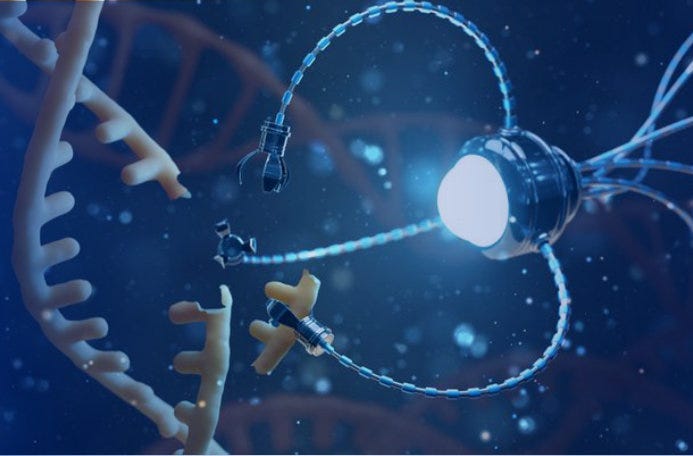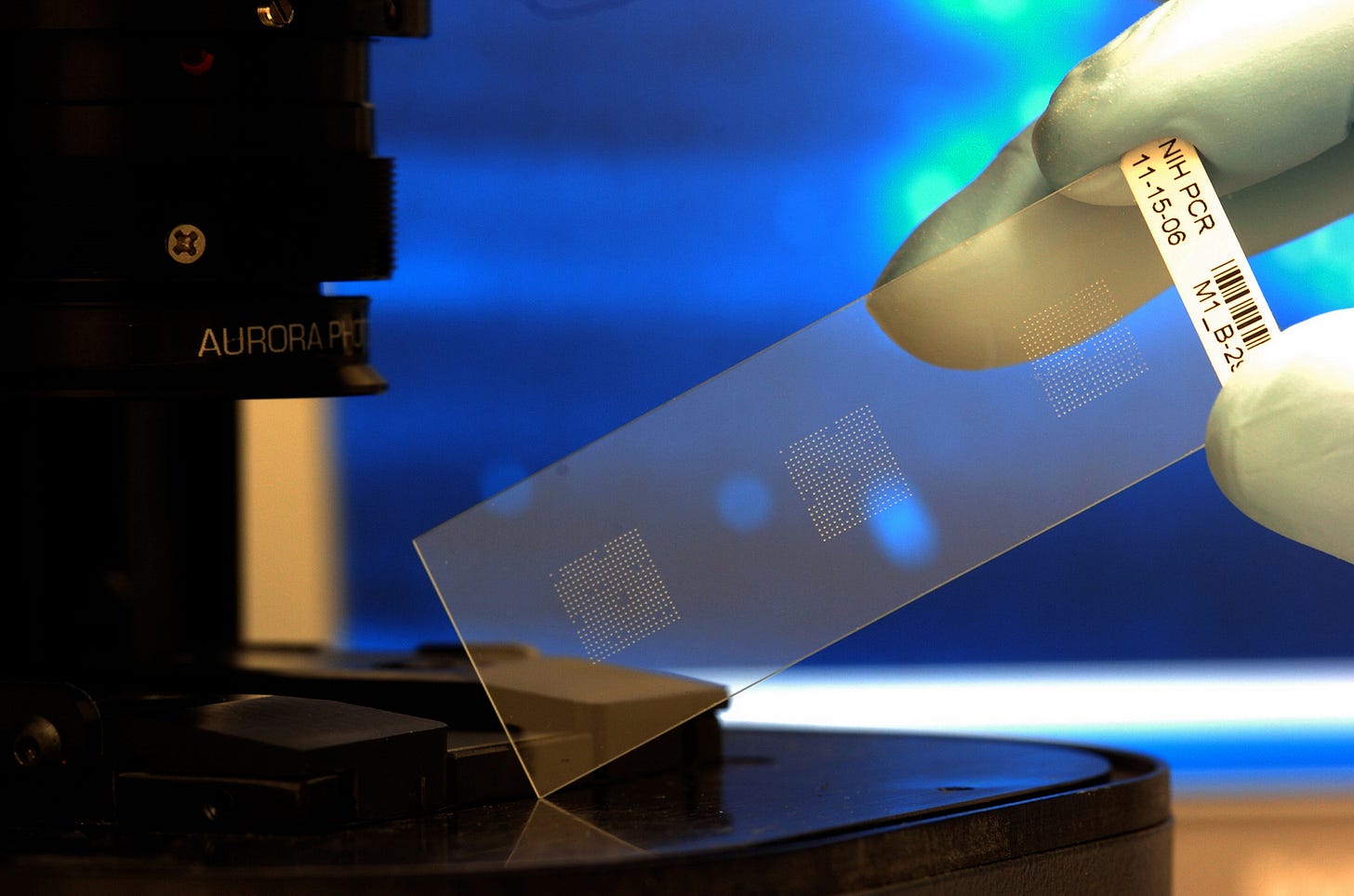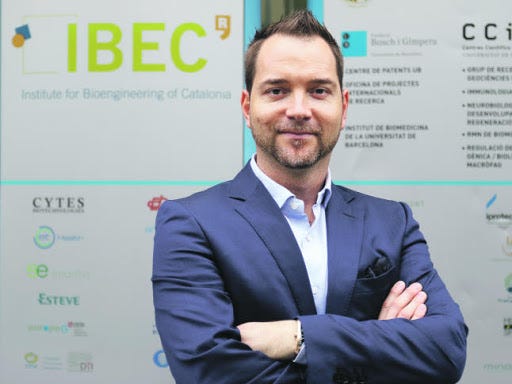Bionanotechnology, the revolution in science. Part I
Nanobiotechnology is the application of nanotechnologies in biological fields
In the following post I would like to give you a short overview of biotechnology. We will see different aspects of it and I will introduce you to some of the researchers that I have had the opportunity to meet in the last few years. As we move forward, we will move on to other fields of nanotechnology.
In this first post I will give you the definition of Biotechnology as well as some of its most important research fields. At the end of the post I will introduce you to Dr. Samuel Sanchez who works at IBEC, Spain.
Perhaps the cover image of this post may seem very futuristic but the reality is that we are moving very fast to arrive at some point to have "ships" that will be nothing more than nanomotors coupled to proteins (enzymes) that can go wherever we send them so that they can perform their function. I have to comment that already in 2004 during the event that we organized in Agelonde (France) Professor Shinji Matsui (University of Hyogo, Japan) presented us with a video where we could appreciate the "arm" of a nanorobot that perfectly picked up a nanoparticle and released it. Maybe it was not the field of Nanobiotechnology but rather of Nanofabrication (since the "fingers" were formed by carbon nanotubes that opened and closed thanks to electrostatic forces but his technology could be used in nanobiotechnology in the future.
Nanobiotechnology is the application of nanotechnologies in biological fields. Chemists, physicists and biologists each view nanotechnology as a branch of their own subject, and collaborations in which they each contribute equally are common. One result is the hybrid field of nanobiotechnology that uses biological starting materials, biological design principles or has biological or medical applications.
While biotechnology deals with metabolic and other physiological processes of biological subjects including microorganisms, in combination with nanotechnology, nanobiotechnology can play a vital role in developing and implementing many useful tools in the study of life.
Nanotechnologies will extend the limits of current molecular diagnostics and enable point-of-care diagnostics, integration of diagnostics with therapeutics, and development of personalized medicine. Although the potential diagnostic applications are unlimited, the most important current applications are foreseen in the areas of biomarker discovery, cancer diagnosis, and detection of infectious microorganisms. Safety studies are needed for in vivo use. Because of its close interrelationships with other technologies, nanobiotechnology in clinical diagnosis will play an important role in the development of nanomedicine in the future.
Nanotechnology-Based Biochips
Nanotechnology on a chip is a new paradigm for total chemical analysis systems. The ability to make chemical and biological information easier and less costly to obtain will impact molecular diagnostics and healthcare. Some examples of devices that incorporate nanotechnology-based biochips and microarrays are nanofluidic arrays and protein nanobiochips. These devices can be adapted for point-of-care use.
One of the more promising uses of nanofluidic devices is isolation and analysis of individual biomolecules, such as DNA. This capability could lead to new detection schemes for cancer. One such device entails the construction of silicon nanowires on a substrate, or chip, using standard photolithographic and etching techniques, followed by a chemical oxidation step that converts the nanowires into hollow nanotubes. With this process, the investigators can reliably create nanotubes with diameters as small as 10 nm, although devices used for biomolecule isolation contain nanotubes with diameters of 50 nm. Trapping DNA molecules requires a device consisting of a silicon nanotube connecting 2 parallel microfluidic channels. Electrodes provide a source of current used to drive DNA into the nanotubes. Each time a single DNA molecule moves into the nanotube, the electrical current suddenly changes. The current returns to its baseline value when the DNA molecule exits the nanotube. Nanofluidic technology is expected to have broad applications in systems biology, personalized medicine, pathogen detection, drug development, and clinical research.
Application of Nanoparticles for Tracking Stem Cells
A superparamagnetic iron oxide (SPIO) nanoparticle is emerging as an ideal probe for noninvasive cell tracking. However, its low intracellular labeling efficiency has limited its use and stimulated interest in the development of new labeling strategies.
The use of 200-nm perfluorocarbon nanoparticles to label endothelial progenitor cells taken from human umbilical cord blood enables in vivo progenitor cell detection by MRI. The MRI scanner can be tuned to the specific frequency of the fluorine compound in the nanoparticles, and only the nanoparticle-containing cells are visible in the scan. This method eliminates any background signals, which often interfere with medical imaging. Moreover, the lack of interference enables measurement of very low amounts of the labeled cells and estimation of their number on the basis of the brightness of the image. Because several perfluorocarbon compounds are available, different types of cells could be labeled with different compounds, injected, and then detected separately by tuning the MRI scanner to the individual frequency of each cell type. This technology offers significant advantages over other cell-labeling technologies in development. Laboratory tests showed that the cells retained their usual surface markers and that they were still functional after the labeling process. The labeled cells were shown to migrate to and incorporate into blood vessels forming around tumors in mice. These methods could soon enable researchers and physicians to use unique signatures from the ingested nanoparticle beacons to directly track cells used in medical treatments. Such tracking ability could prove useful for monitoring tumors and diagnosing as well as treating cardiovascular problems.
Application of Nanoparticles for Discovery of Biomarkers
Currently available molecular diagnostic technologies have been used to detect biomarkers of various diseases. Nanotechnology has refined the detection of biomarkers. Some biomarkers also form the basis of innovative molecular diagnostic tests. The physicochemical characteristics and high surface areas of nanoparticles make them ideal candidates for developing biomarker-harvesting platforms. Given the variety of nanoparticle technologies that are available, it is feasible to tailor nanoparticle surfaces to selectively bind a subset of biomarkers and sequester them for later study using high-sensitivity proteomic tests. Biomarker harvesting is an underutilized application of nanoparticle technology and is likely to undergo substantial growth. Functional polymer-coated nanoparticles can be used for quick detection of biomarkers and DNA separation.
Within Biotechnology I have had the opportunity to meet many important researchers over 18 years organizing Nanotechnology events. I would like to introduce you to one of them that I have chosen for his youth and his research work. His name is Dr. Samuel Sanchez and he works at IBEC. Here is a short biography and an abstract of his last talk in one of our conferences. I also leave you a webminar recently given about his research
Bio: Samuel is since 2015 a Research Professor at the Institute for Bioengineering of Catalonia (IBEC) and the Catalan Institute for Research and Advanced Studies (ICREA) in Barcelona, Spain. Currently he acts as Deputy Director for the Internationalization of IBEC. Before that, he worked at the Max Planck Institute for Intelligent Systems in Stuttgart, IFW Dresden, Germany, MANA-NIMS in Japan. His work spans from fundamental aspects of catalytic and biocatalytic nano-micromotors, 3D Bioprinted BioBOTS, electrochemical biosensors to applications in biomedical and environmental fields. He received several awards and recognitions such as the MIT TR35 as Top Innovator Under 35 in the Spanish edition, Guinness World Records in 2010 and 2017, the Princess of Girona Scientific Research Award 2015 and the National Research Award for Young Talent 2016 by the Catalan Foundation of Research among others. He received the ERC-Starting Grant in 2013, and two ERC-Proof-of-concept in 2016 and 2017. He has published about 130 papers with h-index of 48 and he has filed 6 patents.
Abstract: The combination of biological components and artificial ones emerges into what we called hybrid bots. Alike bacteria or small swimmers found in nature, these artificial nanobots convert bio-available fuels to generate propulsion force to swim at the nanoscale. One of the dreams in nanotechnology is to engineer small vehicles which can eventually be applied in vivo for medical purposes. In my talk, I will present how we bioengineer hybrid nanobots combining the best from the two worlds: biology (enzymes) and (nano)technology (nano- micro-particles) providing swimming capabilities, biocompatibility, remote control, multifunctionality and actuation. I will present some of the proof-ofconcept applications such as the efficient transport of drugs into cancer cells and spheroids, sensing capabilities and the use of molecular imaging techniques for their tracking and localization both in vitro and in vivo in confined spaces like mice bladder.
For 18 years I have been and still am the contact person for the Spanish Nanotechnology Network (Nanospain) and this has encouraged me to start writing in this newsletter. I have had the opportunity to meet first hand Spanish and foreign researchers whose research revolves around Nanotechnology.
I hope you enjoy it. I will try to publish one post per week.
(Remember that this newsletter is more or less weekly, but not always free. If you don't want to miss an issue or any of the special essays, all of which are paid for, you can become a monthly or annual subscriber: click below on "become a paying subscriber" and choose the plan you prefer).






